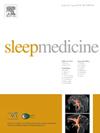Sleepless in the Pursuit of perfection: A longitudinal investigation of bidirectional relationships between insomnia and perfectionism in Adolescent males and females
IF 3.8
2区 医学
Q1 CLINICAL NEUROLOGY
引用次数: 0
Abstract
Study objectives
Perfectionism is a possible risk factor for insomnia, yet longitudinal evidence of this relationship in adolescence is lacking. Cross-sectional evidence suggests the nature of the relationship may differ based on biological sex, and the form of perfectionism, since socially prescribed and self-oriented critical perfectionism are conceptualised as maladaptive for wellbeing, while self-oriented striving may be adaptive or neutral. This study aimed to investigate longitudinal bidirectional relationships between total perfectionism, and sub-forms of perfectionism (i.e., socially prescribed, self-oriented critical, self-oriented striving perfectionism), and symptoms of insomnia, over the course of mid-adolescence. Longitudinal models were examined for males and females separately.
Methods
434 adolescents (Mage = 14.25, SD = 0.56, range = 13–16, 52 % male) completed questionnaire measures of perfectionism (Child-Adolescent Perfectionism Scale) and insomnia (Insomnia Severity Index) on three annual occasions (at approximately 14, 15 & 16 years of age). Data were from the larger Risks to Adolescent Wellbeing (RAW) Project.
Results
Biological sex did not moderate the association between insomnia symptoms and any form of perfectionism. Cross-lagged panel models showed no longitudinal relationship between self-oriented striving, nor self-oriented critical perfectionism and insomnia symptoms for males or females. Higher total perfectionism predicted moderate increases in insomnia symptoms for males and females, but insomnia symptoms did not predict changes in total perfectionism. Socially prescribed perfectionism and insomnia symptoms predicted large and moderate increases in one another over time, respectively, forming a perpetuating cycle.
Conclusions
Results suggest that perfectionism may be an important risk factor for insomnia symptoms in adolescents.
在追求完美的过程中失眠:青少年男女失眠与完美主义之间双向关系的纵向调查。
研究目的完美主义可能是导致失眠的一个风险因素,但目前还缺乏有关这种关系在青少年时期的纵向证据。横断面证据表明,这种关系的性质可能因生理性别和完美主义的形式而异,因为社会规定的和以自我为导向的批判性完美主义被认为对健康不利,而以自我为导向的努力可能是适应性的或中性的。本研究旨在调查青春期中期总完美主义、完美主义的子形式(即社会规定型、自我导向批判型和自我导向奋斗型完美主义)与失眠症状之间的纵向双向关系。方法:434 名青少年(年龄 = 14.25,SD = 0.56,范围 = 13-16,52% 为男性)每年三次(大约在 14、15 和 16 岁时)完成完美主义(儿童青少年完美主义量表)和失眠(失眠严重程度指数)的问卷测量。数据来自规模更大的青少年健康风险(RAW)项目:结果:生理性别并不影响失眠症状与任何形式的完美主义之间的关联。交叉滞后面板模型显示,男性或女性在自我导向的努力奋斗和自我导向的批判完美主义与失眠症状之间没有纵向关系。男性和女性的总体完美主义程度越高,失眠症状就会适度增加,但失眠症状并不能预测总体完美主义的变化。随着时间的推移,社会规定的完美主义和失眠症状会分别预测彼此的大幅和中度增加,从而形成一个持续的循环:结论:研究结果表明,完美主义可能是导致青少年失眠症状的一个重要风险因素。
本文章由计算机程序翻译,如有差异,请以英文原文为准。
求助全文
约1分钟内获得全文
求助全文
来源期刊

Sleep medicine
医学-临床神经学
CiteScore
8.40
自引率
6.20%
发文量
1060
审稿时长
49 days
期刊介绍:
Sleep Medicine aims to be a journal no one involved in clinical sleep medicine can do without.
A journal primarily focussing on the human aspects of sleep, integrating the various disciplines that are involved in sleep medicine: neurology, clinical neurophysiology, internal medicine (particularly pulmonology and cardiology), psychology, psychiatry, sleep technology, pediatrics, neurosurgery, otorhinolaryngology, and dentistry.
The journal publishes the following types of articles: Reviews (also intended as a way to bridge the gap between basic sleep research and clinical relevance); Original Research Articles; Full-length articles; Brief communications; Controversies; Case reports; Letters to the Editor; Journal search and commentaries; Book reviews; Meeting announcements; Listing of relevant organisations plus web sites.
 求助内容:
求助内容: 应助结果提醒方式:
应助结果提醒方式:


